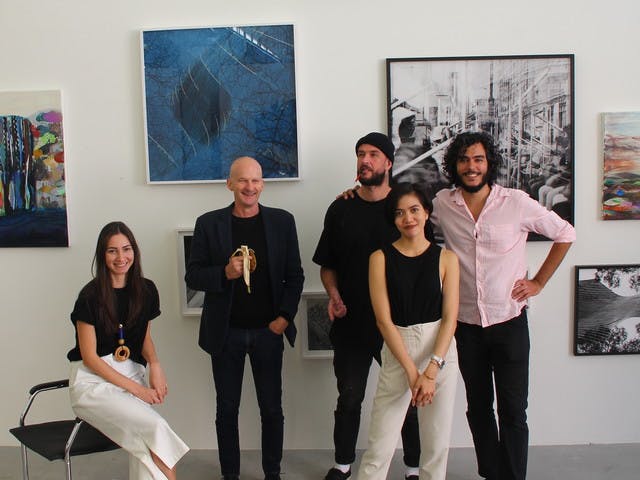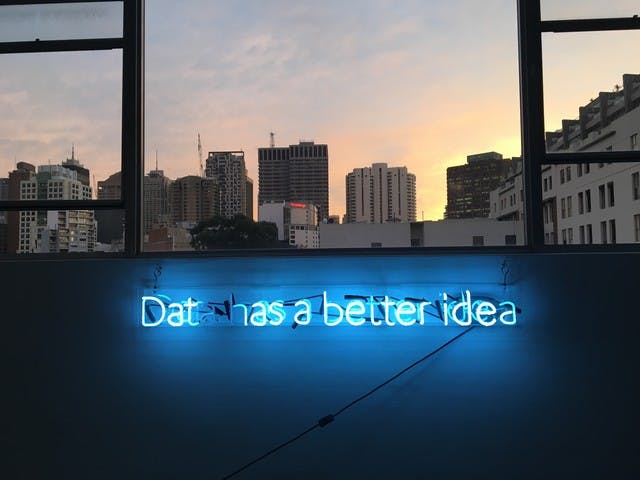Swiss-Brazilian artist Marcelot is currently hosting a studio in situ at coGalleries. His current project, the ambitious "Antike von Heute," aims to explore the state of man in the digital age and draws parallels between modern society and its Greek heritage. The project also investigates the expressive possibilities of newspaper. We sat down with Marcelot to discuss his ideas and his inspiration.
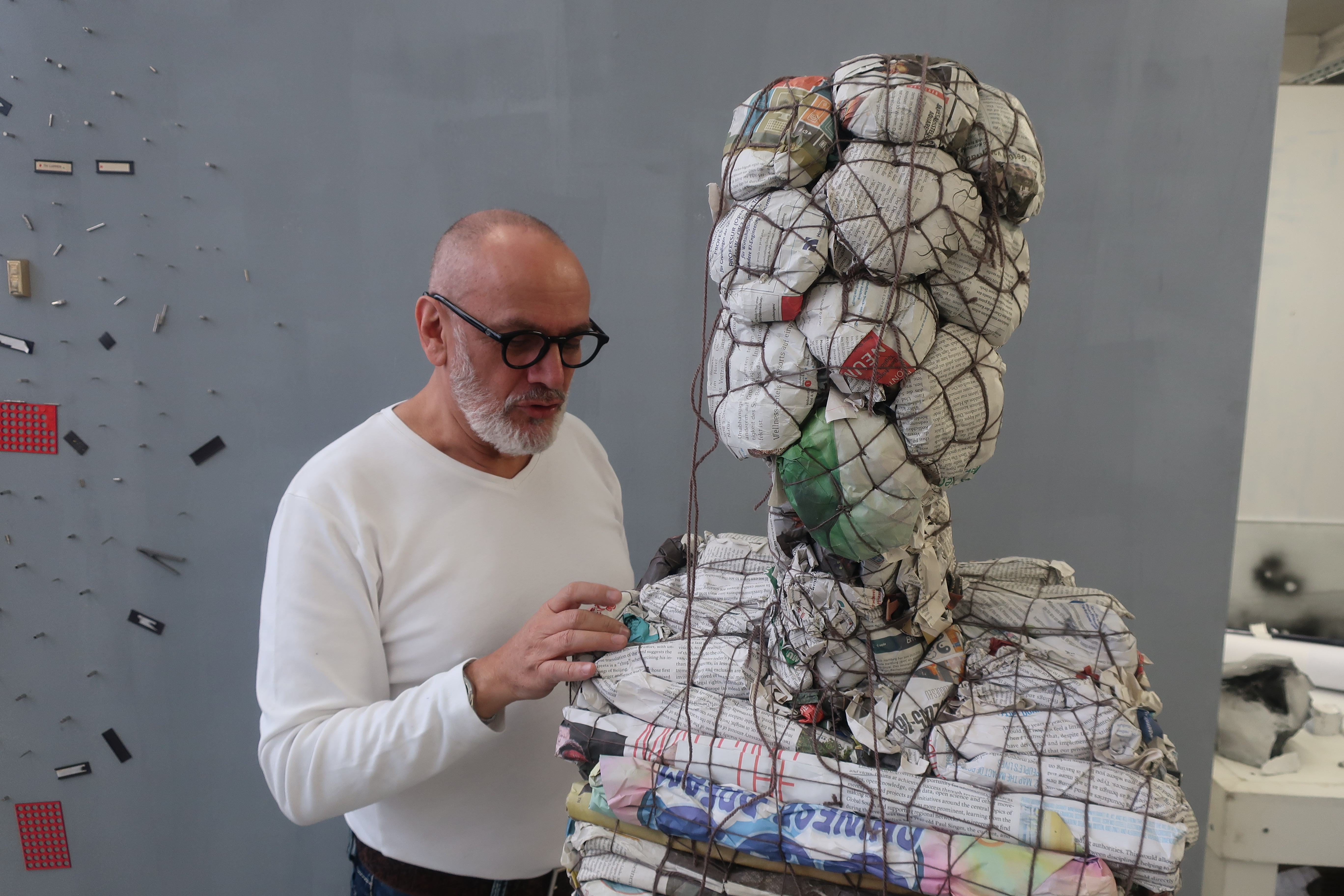
Marcelot with an early iteration of his bust of Angela Merkel | Berlin, October 2020
So what is the general concept behind “Antike von Heute”?
In this project I am trying to promote culture, to provoke a new view of Greek heritage and its connections to the state of mankind at the threshold of the digital era. I’m trying to draw a line between the art of the classical era and the digital era we live in today. I feel that there are lots of parallels between these time periods - lots of things are repeating.
Could you elaborate on some of these parallels?
In some ways the human being has changed very little since Ancient times. What I mean by this is that his primary needs have stayed the same - people desire happiness, long for adventure, wish to be loved and fear death. At a basic level the human being hasn’t changed, but the society he lives in has. And so his secondary needs, those that pertain to his culture, religion, social life and profession are the ones that have really changed. I feel the internet, for example, is like a new Olympus - a place that doesn’t physically exist, but that nonetheless holds a place of enormous importance in society. A number of other aspects of ancient Greek culture are still present in contemporary society - democracy or parliamentarism, for example.
I think the widespread use of photo editing software that we see in the media is another example. If you read Ernst Gombrich’s book “The History of Art”, he says that when a sculptor made a statue of a Greek god they would make an idealised version completely without faults. And if you look in the fashion magazines of today you can see something very similar happening - Photoshop is used to make the models look perfect, to remove any imperfections. These images act as idols to us in a similar way to the statues of the Gods - we look at them and see something we feel we should aspire to.
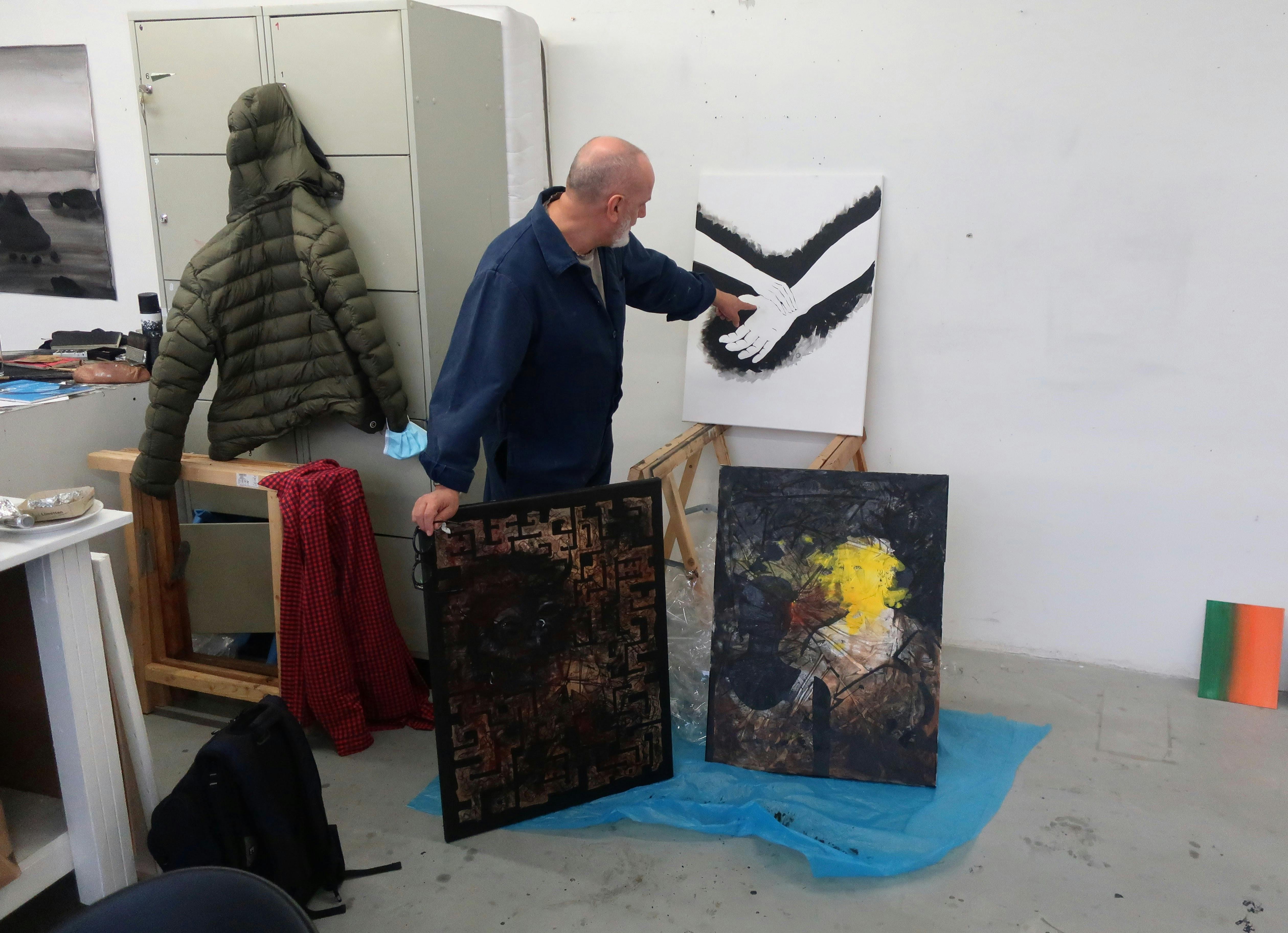
Marcelot with some of his recent work | Berlin, October 2020
When did the idea for this project come to you?
When I was a student of the academy of fine arts in Munich I visited the Glyptothek (the museum of Greek-Roman art), and became fascinated with the beauty of this art. Prior to this I had studied Art Pedagogy in my homeland of Brazil, so I was already familiar with the style, but I had never seen an original sculpture made with marble or bronze. While I was walking in the museum, an idea came to me: ‘What would a contemporary take on Ancient Greek sculpture look like?’ I decided that this could make for an interesting project. I started work on it shortly afterwards, but it was never finished. Years later I decided to return to fine art, after more than ten years working as an art therapist in a psychiatric hospital in Switzerland. I visited the Glyptothek once again, and decided to pick things up where I left off. And so “Antike von Heute” was born.
Why did you choose to work with newspaper?
When I was in my twenties I spent a few years working as a teacher in Brazil. I often worked with children from poor communities, and we didn’t have a lot of funding. Because of this we had to make the most of the resources that were available to us - these included a lot of newspaper so I started using it as a prop to teach my classes. When I later came to study in Germany I found myself in a similar situation. I was invited to study at the academy of Fine Arts in Munich - an exciting but nerve wracking prospect given that I spoke very little German! When I got there I wanted to start work on a sculpture, but found that I had little in the way of materials to work with. As a result I once again had to make the most of what I had - newspaper. So the decision to work with newspaper was a spontaneous one made out of necessity.
However, as I worked I found myself reflecting on my choice of material. I wondered if there was an artistic reason to continue using newspaper. If I was only interested in the aesthetic qualities of an object I would of course have switched to another type of paper, for example japanese paper or rice paper, because they don’t deteriorate in the way that newspaper does. Newspapers are brittle and yellow with time, but they also represent an idea - information. This was the start of my work with the “pre-ideas” of objects - using them not just for their appearance but for the ideas they represent. In the case of newspaper the material represents information. Additionally, newspaper as a physical information carrier is currently threatened with extinction. It is antiquated, and yet simultaneously persists throughout contemporary society. Thus it is an "Antike von Heute"; an antique of today.
So the newspaper in your work represents information?
Yes - but I want to stress that I am using newspaper only to realise THIS specific project, it isn't my only medium. What IS present throughout my work is this concept of the “pre-ideas” carried by objects. In my other projects, I use other objects as stand-ins for their own individual connotations.

Marcelot working on his bust of Angela Merkel | Berlin, November 2020
In “Heads of Power”, one of the twelve interventions that make up “Antike von Heute”, you make newspaper busts of contemporary political figures. What message are you trying to communicate with these pieces?
In the ancient world, busts were a common representation of power. The Romans would build busts of their leaders, the Greeks of their Gods, and the busts acted as physical manifestations of the power of these entities. We don’t see such busts of leaders today, power isn’t represented through grand gestures or labour-intensive works of art. It is instead, in my opinion, embodied through information.
Today a public figure is defined by their presence in the media. What is written about them can deify them or destroy them, and a lot of political decisions are heavily influenced through both the manipulation of information and the dissemination of misinformation. In making these busts I am trying to make this link more explicit. As I mentioned before, the newspaper in my work represents information. Modern political figures are not placed on a physical pedestal in a temple or palace, but instead are placed on a metaphorical one constructed by the media. Their power is built from information - and so their busts will be built from it too. I started with a bust of Jair Bolsonaro, and now that I’m in Berlin I’m working on a bust of Angela Merkel made from local newspaper.
Are you trying to make a political statement with the busts?
In my work I am political but not partisan. Politicians like Bolsonaro, Trump or Erdogan polarise. It is difficult to hold a neutral position and not be for or against them. The project of my residency in Brazil was to “realize a bust of the new Brazilian president”. Bolsonaro would not be my choice of candidate, but when the majority of Brazilians voted for him, who am I to say to the contrary? He became the new Brazilian president. During the exhibition some supporters of Bolsonaro were enthusiastic about the bust. A man approached me, but he was not interested to know who I was, only to ask me to take a picture of him and his family beside the sculpture. On the other hand some visitors turned on their heels when they recognised Bolsonaro. But what I hope people understand is that neither of these things are my intention - the work is intended as a commentary on power in the information age, and not as a statement either for or against the politician in question. As I said, I picked Bolsonaro simply because he is the president of Brazil. Of course I am interested in politics, but more than this I am interested in ideas, in art and in artists.
What do you make of the current political climate? Issues across the globe have become so polarised, it must be difficult to avoid partisanship in your work.
During my course of analysis of groups I understood that after a time of fusion and tolerance comes a time of separation and split. These things come in cycles, and I think this kind of social manifestation spreads over the political climate too. At least I hope so!
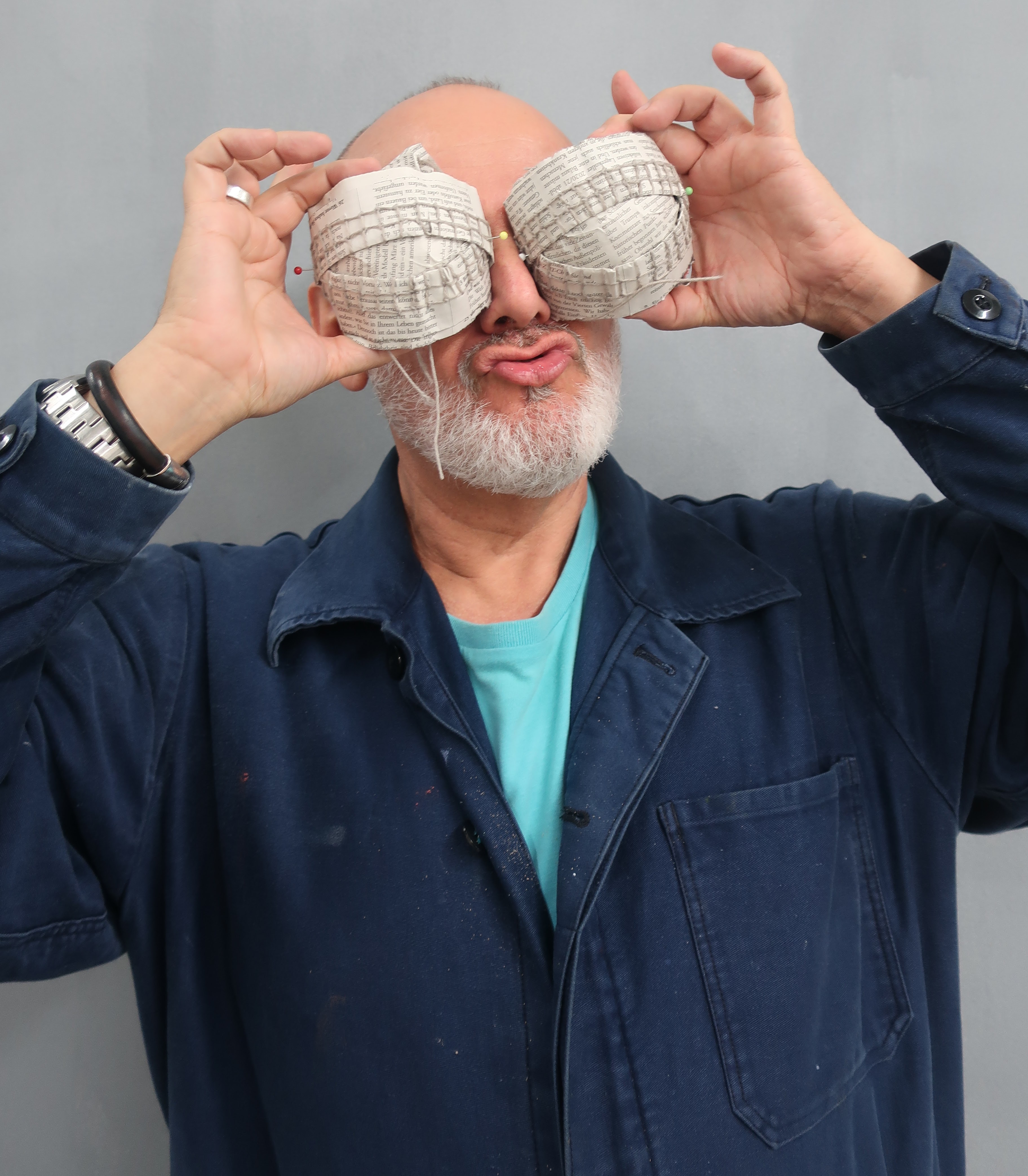
Marcelot at coGalleries | Berlin, November 2020
“Heads of Power” is just one part of “Antike von Heute” - what else does the project entail?
The project contains eleven or twelve ‘interventions’. Some of them are simple, like the ‘Medusa’, which was one of the first pieces I completed for this project. The Medusa to me is analogous to the news in the age of social media as we are supposed to be petrified by what we read. I tried to illustrate this by constructing a newspaper Medusa. This didn’t take me too long as I only had to build one figure, but some of the other interventions are a little more work-intensive.
Currently I am focusing on the interventions which require more time to realize, these being the ‘Heads of Power’ and the ‘Circle of the Gods’.
Greek and Roman museums will often have a courtyard of sorts in the middle, in which there will be a collection of pictures of the Gods. My idea for the ‘Circle of the Gods’ intervention is to recreate this, but with every day Greek people modelling as the Gods. The process will be documented and exhibited as the twelfth and final intervention.
And what is the intention behind this?
My intention here is twofold. Part of it is that I am interested in how people on the internet construct their own identities, really in this era you can be whoever you want to be, even a God. The other part is a little less thematic; I just like the idea of allowing normal young people to feel like a God, to feel put on a pedestal, to feel seen. I think that’s a wonderful thing, and of course it ties back into the major themes of the project; in the era of social media we are all on display, just like the idols we see in museums. This particular part of the project has been a little bit of a challenge so far, I’ve only completed a few of the Gods and I don’t have a deadline in mind for it.
Why has it been a challenge?
Honestly? The inconsistency of the models! (laughs) Posing for one of these photos takes more skill than you might imagine, I need my models to have expressive faces so that they can represent the different Gods. One of my models could only pull one facial expression, that was something that I’d never seen before. I had to go into photoshop and move his eyebrows myself!
What are your plans for the future of this project?
I would love to get a chance to show my project in a museum. I like the idea of seeing busts of Roman emperors side by side with those of Xi Jinping made out of a Chinese newspaper or Vladimir Putin made out of Pravda. I think we tend to look at these busts as merely beautiful objects, we forget their original context. This juxtaposition would remind the audience of what they really mean whilst also making us think about the place our leaders take in contemporary society.
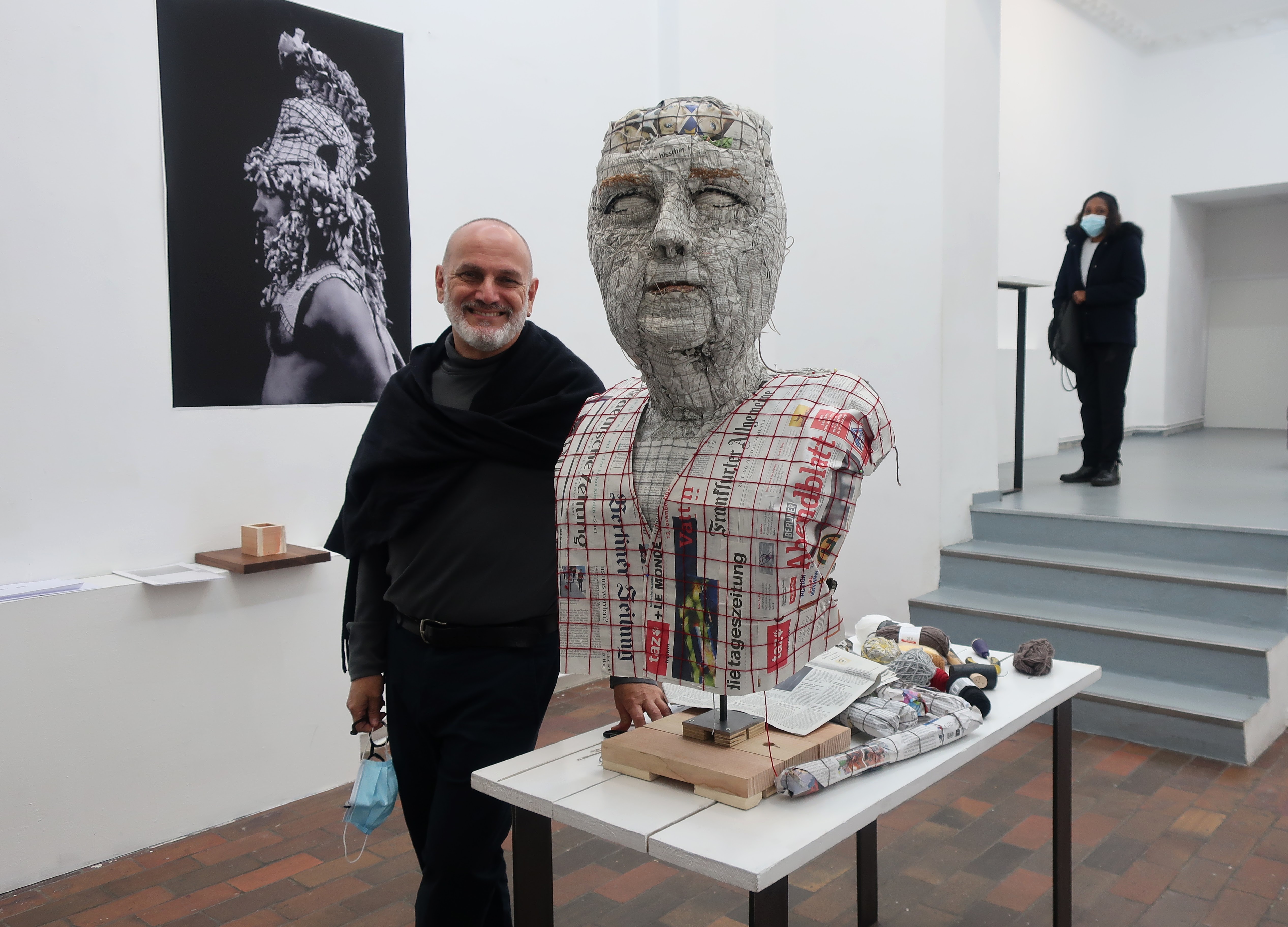
Marcelot and Angela at coGalleries | Berlin, November 2020
You recently returned to working full time as an artist after spending a decade working as an art therapist. What motivated you to return to making art full time?
I always used to say that “as a therapist I am a mirror” and “as an artist I am a picture”. In therapy the person painting and expressing themselves is the patient, not the therapist, and so it was important that I focus on listening to them. But I think that I have a lot to say too! So I decided to return to the fine arts, so I could express my own ideas.
What do you feel is the most important thing you learnt in your time as an art therapist?
I’m glad that I spent time working as an art therapist because I feel it taught me the importance of intention in art. My impression is that a lot of artists don’t have a real intention behind their work. They create art with a decorative purpose in mind. But when an artist works with intention it comes across in the work in a way that you can really feel.
As a therapist I would use art as a means to facilitate greater communication with and understanding of my patients. For example one of my patients painted a hole with a dark substance dripping from it. Looking at the painting made me feel very sad, and later I realised that she had relayed what she was feeling to me through the painting. The painting had allowed her to articulate her emotions in a way that she couldn’t with words. I think this non verbal form of communication is something really special. It allows you to express things that would otherwise be bound within your own consciousness. If the people who see your art feel the same way as you, it can give them a means to reflect on their own emotions. But this is only possible when the work is made with intention, when the artist is trying to express something through the work.
This is also why I don’t like spending too long on a given piece; I feel it takes the spontaneity out of the work, and this can have a detrimental effect on the feeling embodied in it. These sculptures are a bit of a change of pace for me as they each take a few months to complete.
What do you think is more important? The meaning of a piece of art to its audience or to its creator?
I would say both are equally important. The more the artist is sure in what they are trying to express, the more the audience will feel and understand the message. I will say however that if you weigh the value of your work on the opinion of the audience, then you are lost. Audiences are fickle, one day they will like something and two days later they will move on to something else. People look for art to be a mirror, and whether or not they like your work has to do with them and not to do with you. All you can do as an artist is to make art that you feel expresses your own feelings, and to hope that it will resonate with those who share them.
That being said, I think art is so human, you create art for other human beings and you are looking for connection. And so both your feelings on your own work and the way it resonates with your audience matter immensely because that dialogue is what creates the sense of connection.
What made you decide to come and do a residency in Berlin?
My main goal for this residency is to consolidate my identity as an artist. I feel that I am constantly being required to justify myself, to explain what I’m doing and to prove that I am an artist, both to others and to myself. Perhaps some artists do not have a problem feeling comfortable with identifying themselves as such but for me it is not so self-evident. None of my family or friends in Brazil are artists, I am the first one, the only one. I put myself under a lot of pressure because I am used to people saying “What are you thinking?” and telling me that I am not an artist.
Throughout much of my life I have felt that people are trying to put me in a box - “You are a photographer” - Yes, but not only. “You are a painter” - Yes, but not only. For the last decade I have been first and foremost an art therapist and I feel increasingly pigeonholed. It feels as if I got on a train all those years ago, and now that it has taken me down a certain path it has become difficult to reroute. Me coming here and doing this residency is my way of getting off that train. Here in Berlin I am not a Brazilian, or a therapist, or a teacher, or a friend or a lover. I am simply an artist.
Do you feel you have benefitted from having input from other people?
Yes definitely - discussing my residency with other people has really helped to refine my ideas. Sometimes people challenge my opinions in a way I hadn’t considered and I have to stop and rethink them. I think this is a healthy process - it’s important to be challenged sometimes because it makes you refine your arguments and as a result makes your ideas more well rounded. If you have the courage to expose your art to criticism you get a lot of feedback, and if you are willing to listen you gain an opportunity to learn a lot about your work and to improve. Of course no one likes to receive criticism - I would love to be loved, I think we all would. But sometimes negative feedback can be really important - when I have to defend my work I find that I later have a clearer idea of what I’m doing and why I’m doing it.
Marcelot's studio in situ will be running from 19 - 23 November, 6 - 9 pm at Torstraße 170. If you wish to attend please book a slot using the following form:
https://doodle.com/poll/i4e27z6wr2i8rfgq?utm_source=poll...
Interview conducted by Fergus Brown.
Photography by Fergus Brown.

